“Plant” Your Weekend: Tour A World of Plants
Posted in Exhibitions, Exhibitions, Video on February 19 2010, by Plant Talk
 |
Rustin Dwyer is Visual Media Production Specialist at The New York Botanical Garden. |

Inside The New York Botanical Garden
Posted in Exhibitions, Exhibitions, Video on February 19 2010, by Plant Talk
 |
Rustin Dwyer is Visual Media Production Specialist at The New York Botanical Garden. |
Posted in Exhibitions on February 11 2010, by Plant Talk
 |
Laura Collier is Marketing Associate at The New York Botanical Garden |
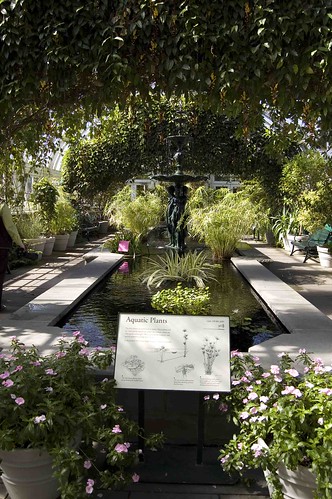 To me, the sound of water is an immediate stress reliever. Walking into the Aquatic Plants and Vines Gallery in A World of Plants in the Enid A. Haupt Conservatory is almost like stepping into a spa or meditation center. Water trickles down the 19th-century French cast-iron fountain of the Three Graces, representing joy, charm, and beauty in Greek mythology. Papyrus, a personal favorite and a plant you probably associate with ancient Egyptian paper, stands energetically at the entrance. These plants can make a great, easy-to-care-for addition to your home if you have a sunny space.
To me, the sound of water is an immediate stress reliever. Walking into the Aquatic Plants and Vines Gallery in A World of Plants in the Enid A. Haupt Conservatory is almost like stepping into a spa or meditation center. Water trickles down the 19th-century French cast-iron fountain of the Three Graces, representing joy, charm, and beauty in Greek mythology. Papyrus, a personal favorite and a plant you probably associate with ancient Egyptian paper, stands energetically at the entrance. These plants can make a great, easy-to-care-for addition to your home if you have a sunny space.
Above the pool, jade and other vines climb up the walls and ceiling of the Gallery. In nature, climbing plants keep moving upward to seek the light, using adhesive pads, hooks, or even roots. In dense forests, climbers need to move quickly to compete with trees for light. Under the glass roof of the Conservatory, there isn’t the need to break through the canopy to find the sun, and the vines are plentiful over lily-pads and other water plants in the pool below.
After wandering through the Deserts of the World and the Tropical Rain Forest Galleries, the benches in the Aquatic Gallery provide an inviting place for a rest. Have a seat and soak in the relaxing atmosphere for a moment.
Posted in Exhibitions on February 4 2010, by Plant Talk
 |
Laura Collier is Marketing Associate at The New York Botanical Garden |
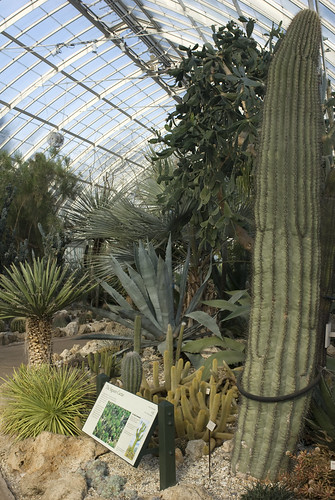 Deserts cover about a third of the Earth’s surface but are so extreme that just about 5 percent of the world’s population live there. That doesn’t make them devoid of plant life. Quite to the contrary, thousands of plant species have adapted survival techniques, like sun protection and water storage, to be able to live in the desert climate, and you can see some of these in the Deserts of the World Gallery in A World of Plants in the Enid A. Haupt Conservatory.
Deserts cover about a third of the Earth’s surface but are so extreme that just about 5 percent of the world’s population live there. That doesn’t make them devoid of plant life. Quite to the contrary, thousands of plant species have adapted survival techniques, like sun protection and water storage, to be able to live in the desert climate, and you can see some of these in the Deserts of the World Gallery in A World of Plants in the Enid A. Haupt Conservatory.
Cacti, the plants we typically think of when talking about deserts, come in many shapes and sizes. One of the most famous in the United States is the saguaro of the Sonoran Desert in the southwestern part of the country. Saguaros can grow to 50 feet tall with roots extending 100 feet into the ground, and can live up to 200 years. These giants play an important role in the desert, providing food and shelter for animals, insects, and birds.
Posted in Exhibitions, The Orchid Show on February 3 2010, by Plant Talk
Designer Visits from Florida to View Progress of Installation
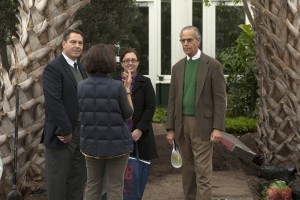 Jorge Sánchez (right), designer of The Orchid Show: Cuba in Flower, and John C. Lubischer (left), Senior Associate of the Palm Beach-based landscape architectural firm Sánchez & Maddux, visited the Botanical Garden last week to view the progress of the installation, which includes an allée of palm trees, a sugar mill ruin, and other iconic vignettes of Old Havana and the Cuban countryside—amid fabulous orchids. “All the pieces are fitting into place flawlessly—with grace and good humor,” Jorge said. “What a pleasure to be working with such a well-organized group.” Here he talks with Garden staff Francisca Coelho, Senior Curator and Associate Vice President for Glasshouses and Exhibitions (back to camera), and Karen Daubmann, Director of Exhibitions and Seasonal Displays, in the Enid A. Haupt Conservatory, where the exhibition will run from February 27 through April 11.
Jorge Sánchez (right), designer of The Orchid Show: Cuba in Flower, and John C. Lubischer (left), Senior Associate of the Palm Beach-based landscape architectural firm Sánchez & Maddux, visited the Botanical Garden last week to view the progress of the installation, which includes an allée of palm trees, a sugar mill ruin, and other iconic vignettes of Old Havana and the Cuban countryside—amid fabulous orchids. “All the pieces are fitting into place flawlessly—with grace and good humor,” Jorge said. “What a pleasure to be working with such a well-organized group.” Here he talks with Garden staff Francisca Coelho, Senior Curator and Associate Vice President for Glasshouses and Exhibitions (back to camera), and Karen Daubmann, Director of Exhibitions and Seasonal Displays, in the Enid A. Haupt Conservatory, where the exhibition will run from February 27 through April 11.
Posted in Exhibitions on January 29 2010, by Plant Talk
 |
Laura Collier is Marketing Associate at The New York Botanical Garden |
 Chocolate, papaya, guava, cashews—the list of plants in the Tropical Lowland Rain Forest of A World of Plants in the Enid A. Haupt Conservatory seems strangely like the list of my favorite foods.
Chocolate, papaya, guava, cashews—the list of plants in the Tropical Lowland Rain Forest of A World of Plants in the Enid A. Haupt Conservatory seems strangely like the list of my favorite foods.
Beyond food, the rain forest provides us with an incredible diversity of plants and animal life. Though they cover less than 7 percent of Earth’s surface, rain forests contain almost one-third of the planet’s known plant species. Medicines like aspirin and codeine are derived from rain forest plants, and scientists are hopeful for more plant-based drugs that may be integral in therapies for cancer and HIV/AIDS.
In the gallery the warmth and humidity immediately make me feel like I’m back in the Amazon rain forest, especially because my glasses fog up after being out in the cold. By far the best view in the gallery is from atop the skyway platform. From there you can enjoy the canopy and survey the rich greenery all around. Before you move on to the next gallery, be sure to check out the healer’s hut, with samples and information about traditional uses of plants in the forest.
Posted in Exhibitions, The Orchid Show on January 28 2010, by Plant Talk
Massive Palms Arrive from Florida for Cuba-Themed Installation
![image[1]](https://www.nybg.org/blogs/plant-talk/wp-content/uploads/2010/01/image11-150x150.png)
 Twenty-one Sabal palmetto palms, each over 1,200 pounds and about 15 feet tall, were loaded in Deland, Florida (top photos by John Lubischer), for a two-day trip to New York to be included in The Orchid Show: Cuba in Flower, which opens February 27. On arrival at the Garden last week (three bottom photos), they were unloaded to be planted in the seasonal galleries of the Enid A. Haupt Conservatory, where they will create a dramatic canopy effect, surrounded by a stunning display of orchids designed by Cuban-reared landscape architect Jorge Sánchez.
Twenty-one Sabal palmetto palms, each over 1,200 pounds and about 15 feet tall, were loaded in Deland, Florida (top photos by John Lubischer), for a two-day trip to New York to be included in The Orchid Show: Cuba in Flower, which opens February 27. On arrival at the Garden last week (three bottom photos), they were unloaded to be planted in the seasonal galleries of the Enid A. Haupt Conservatory, where they will create a dramatic canopy effect, surrounded by a stunning display of orchids designed by Cuban-reared landscape architect Jorge Sánchez.
![image[3]](https://www.nybg.org/blogs/plant-talk/wp-content/uploads/2010/01/image3-150x150.png)
![image[2]](https://www.nybg.org/blogs/plant-talk/wp-content/uploads/2010/01/image2-150x150.png)
![image[4]](https://www.nybg.org/blogs/plant-talk/wp-content/uploads/2010/01/image4-150x150.png)
Posted in Exhibitions on January 21 2010, by Plant Talk
 |
Laura Collier is Marketing Associate at The New York Botanical Garden |
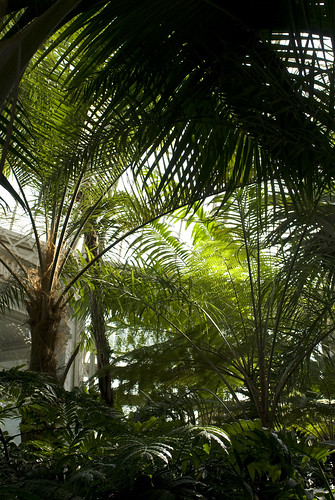 An acre of tranquility awaits you in A World of Plants in the Enid A. Haupt Conservatory at the Garden. Lush palm trees, exotic rain forests, and serene deserts provide the perfect getaway right here in New York. Rejuvenate your senses as you journey through the palms of the Americas and tropical rain forests, past pools of waterlilies and striking desert cacti.
An acre of tranquility awaits you in A World of Plants in the Enid A. Haupt Conservatory at the Garden. Lush palm trees, exotic rain forests, and serene deserts provide the perfect getaway right here in New York. Rejuvenate your senses as you journey through the palms of the Americas and tropical rain forests, past pools of waterlilies and striking desert cacti.
This week we take an up-close look at the Palms of the Americas Gallery.
The most extensive collection of palms in the Americas, both North and South, welcome you from the cold, into the Conservatory. With more than 550 different types identified in the Americas alone, palms are one of the most diverse species on Earth. They range greatly in height from the tiny, six-inch lilliput palm to the towering wax palm of the Andes, which would lift the 90-foot dome off the Conservatory if allowed to grow to its full height.
Surrounding the reflecting pool you’ll see a set of five royal palms, native to Cuba. These and several other varieties in the Palms of the Americas Gallery provide the perfect entrance to your retreat, their fronds softly giving shade from the sun shining through the Victorian-style glass roof.
Find out more about A World of Plants, explore the photo gallery, and check out family activities here.
Posted in Exhibitions on January 15 2010, by Plant Talk
 Step out of the winter blahs and into your own retreat. A World of Plants in the Enid A. Haupt Conservatory lets you enter tropical rain forests, mountain slopes, and deserts full of exotic plants. Step out of the winter blahs and into your own retreat. A World of Plants in the Enid A. Haupt Conservatory lets you enter tropical rain forests, mountain slopes, and deserts full of exotic plants.
Tour an acre of living beauty under glass in the Conservatory, either on your own, through the use of free audiotours, or on a docent-led tour. Make an entire day of your trip, enjoying lunch at one of our Cafes and pampering yourself at Shop in the Garden. The Garden is open on Monday for the Martin Luther King Jr. holiday. And don’t forget the kids! The Everett Children’s Adventure Garden is always open for family fun. |
Posted in Exhibitions, Holiday Train Show on January 8 2010, by Plant Talk
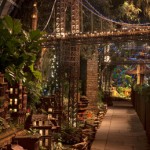 All your favorite New York landmarks are in one place for one final weekend of the Holiday Train Show. This is your last chance to: All your favorite New York landmarks are in one place for one final weekend of the Holiday Train Show. This is your last chance to:
• See the trains among twinkling lights wind past the old Yankee Stadium, the Brooklyn Bridge, and, new this year, the original Penn Station and Brooks Brothers flagship store. • Become an honorary engineer and take a picture with Thomas the Tank Engine™ along with his friend, Sir Topham Hatt, from 10 a.m. to 5 p.m. • Make a field notebook about ginger, cinnamon, and other spices in Gingerbread Adventures. Save room for decorating and sampling gingersnaps! Don’t miss this holiday tradition. Get your tickets today! |
Posted in Emily Dickinson, Holiday Train Show on January 6 2010, by Plant Talk
Celebrating the Season and Looking Ahead to Our Spring Exhibition
 Carol Capobianco is Editorial Content Manager at The New York Botanical Garden.
Carol Capobianco is Editorial Content Manager at The New York Botanical Garden.
Garden staff members have been busy learning all they can about Emily Dickinson and her poetry in advance of the Botanical Garden’s spring exhibition, Emily Dickinson’s Garden: The Poetry of Flowers, May 1–June 13, 2010. We take note wherever and whenever we see her name.
So when we saw in a datebook, by chance, a gingerbread recipe by Emily Dickinson, we decided to blog about it, since the Garden currently is presenting Gingerbread Adventures in the Everett Children’s Adventure Garden as part of the Holiday Train Show.
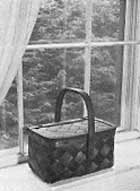 With a little digging around I learned that Dickinson had a bit of a reputation as a baker in her hometown of Amherst, Massachusetts. In fact, she was particularly known for her gingerbread (and Rye and Indian bread), and would lower a basket of it to children below (photo by Lewis S. Mudge, courtesy of his estate), according to Emily Dickinson: Profile of the Poet as Cook, with Selected Recipes, by Nancy Harris Brose, Juliana McGovern Dupre, Wendy Tocher Kohler, and Jean McClure Mudge, and published in 1976. We have a copy of this 28-page booklet in the LuEsther T. Mertz Library, where in spring 60 objects that tell the story of Dickinson’s life will be on view in the Rondina and LoFaro Gallery. (Complementing this will be a re-creation of her garden in the Enid A. Haupt Conservatory and a poetry walk throughout the Garden’s grounds.)
With a little digging around I learned that Dickinson had a bit of a reputation as a baker in her hometown of Amherst, Massachusetts. In fact, she was particularly known for her gingerbread (and Rye and Indian bread), and would lower a basket of it to children below (photo by Lewis S. Mudge, courtesy of his estate), according to Emily Dickinson: Profile of the Poet as Cook, with Selected Recipes, by Nancy Harris Brose, Juliana McGovern Dupre, Wendy Tocher Kohler, and Jean McClure Mudge, and published in 1976. We have a copy of this 28-page booklet in the LuEsther T. Mertz Library, where in spring 60 objects that tell the story of Dickinson’s life will be on view in the Rondina and LoFaro Gallery. (Complementing this will be a re-creation of her garden in the Enid A. Haupt Conservatory and a poetry walk throughout the Garden’s grounds.)
My intention was simply to post the recipe here, with permission from Jean Mudge, and let you try it out for yourself. However, I got caught up in the “everything Emily” mood, and to celebrate her 179th birthday (December 10), I decided to try making the recipe myself to share with co-workers.